目次
5月号【法務】ニュースレター
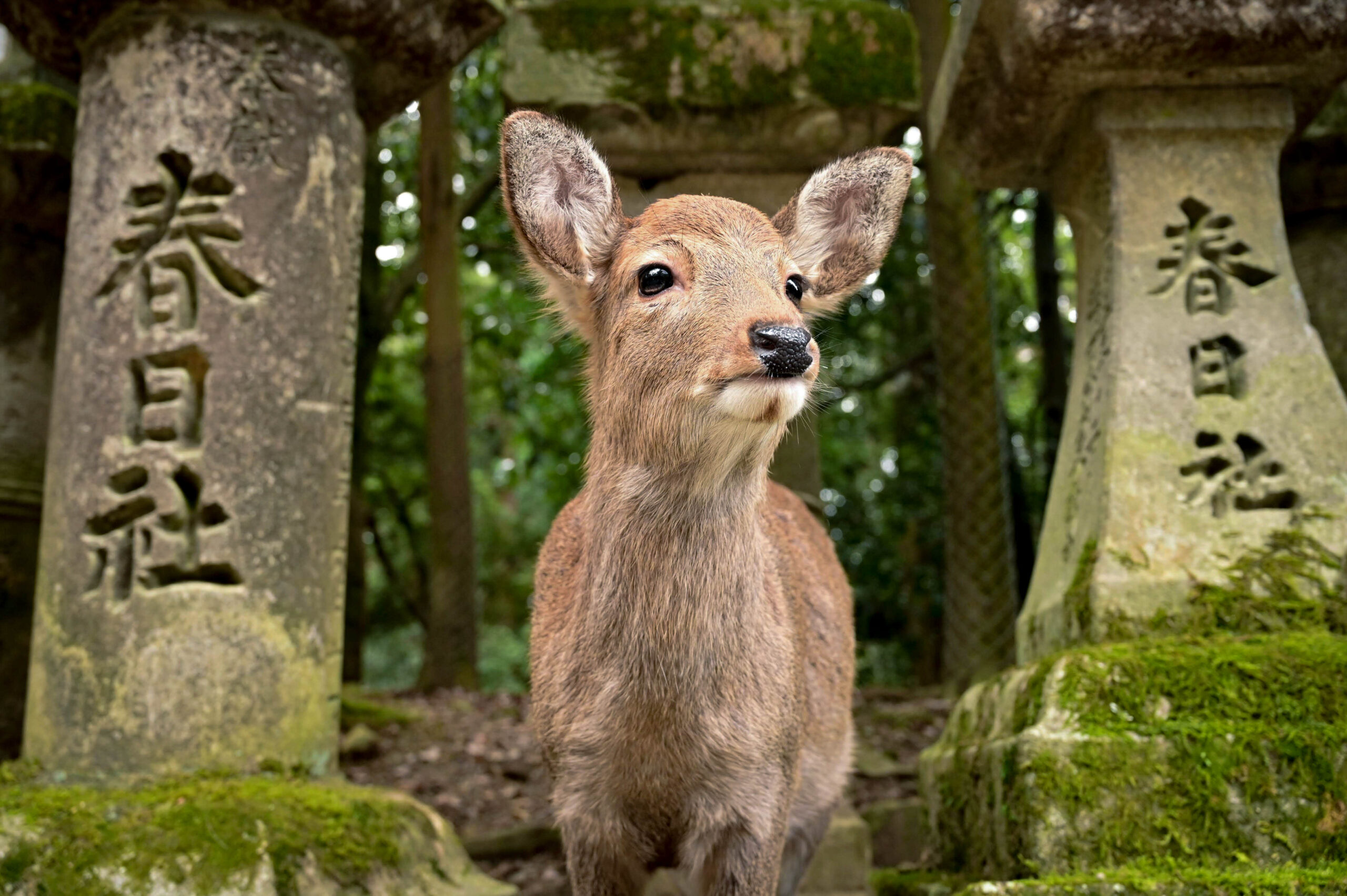
特許庁:仮想空間及び非代替性トークン(NFT)に関する指定商品・指定役務のガイドラインを公表
2024年3月29日、特許庁は仮想空間及び非代替性トークン(NFT)に関する指定商品・指定役務のガイドラインを公表した。
近年、仮想空間のビジネスへの活用が進んだことを背景に、仮想空間に関する商品・役務を指定する商標登録出願が増加傾向にある。この度、特許庁は仮想空間及び非代替性トークン(NFT)に関する指定商品・指定役務のガイドラインを作成し、現在の運用を明確にした。
1.仮想商品について
「仮想商品」とは、「主に仮想空間(注1)上で商品等の形状を表示するためのデジタルデータ」をいう。「仮想商品」は、どのような商品等の形状を表すものか不明確であり、広範であるため、単独では指定商品又は指定役務の表示として採用できない。また「仮想被服」とした場合でも不明確であるため、単独では指定商品又は指定役務の表示として採用できない。
(注1)仮想空間とは「多人数が参加可能で、参加者がその中で自由に行動できるインターネット上に構築される仮想の三次元空間」をいう。
(1)採用可能な指定商品又は指定役務の表示
国際的な調和の観点から、以下の表示であれば指定商品・指定役務の表示として採用可能である。
第9類「ダウンロード可能な仮想被服」
第9類「仮想空間で被服を表示するためのダウンロード可能なコンピュータプログラム」
第9類「仮想空間で被服を表示するためのダウンロード可能な画像ファイル」
第35類「オンラインによるダウンロード可能な仮想被服の小売の業務において行われる顧客に対する便益の提供」
第41類「仮想空間で被服を表示するためのオンラインによる画像の提供」
第42類「仮想空間で被服を表示するためのコンピュータプログラムの提供」
そして、上記の表示はいずれも「被服」の部分について、類似商品・役務審査基準等に掲載されている商品(すなわち、単独で指定商品の表示として採用可能な表示)に置き換えることができる。
(2)採用できない指定商品又は指定役務の表示
上記(1)で表示された指定商品又は指定役務のうち「被服」部分が広範で不明確な表示。
上記(1)で表示された指定商品又は指定役務とよく似た表示ではあるが一致しない表示。
例「ダウンロード可能な仮想商品」、「ダウンロード可能な仮想の被服」
2.非代替性トークン(NFT)について
「非代替性トークン(NFT)」とは、「偽造・改ざん不能のデジタルデータ」であり、ブロックチェーン上で、デジタルデータに唯一性を付与して真贋性を担保する機能や、取引履歴を追跡できる機能を有するところ、当該語は「アート作品など、複製でないことに価値があるものに、それが唯一のデータであることを証明する情報を埋め込んだもの」の意味でも用いられる。したがい、「非代替性トークン(NFT)」、「非代替性トークン」及び「NFT」は、単独ではその意味合いが特定できず不明確であるため、指定商品又は指定役務の表示として原則採用できない。ただし、下記の表示であれば採用可能である。
第9類「非代替性トークン(NFT)により認証されたダウンロード可能なデジタル画像ファイル」
第9類「非代替性トークン(NFT)生成用のダウンロード可能なコンピュータソフトウェア用アプリケーション」
第25類「非代替性トークン(NFT)により認証された現実の被服」
第35類「非代替性トークン(NFT)により認証されたダウンロード可能なデジタル画像ファイルの小売の業務において行われる顧客に対する便益の提供」
第35類「非代替性トークン(NFT)により認証されたダウンロード可能なデジタル画像ファイルの買い手及び売り手のためのオンライン市場の提供」
第35類「非代替性トークン(NFT)により認証されたダウンロード可能なデジタル画像ファイルのオンライン市場への出品事務手続の代行」
第35類「デジタル画像ファイルの非代替性トークン(NFT)による認証取得のための事務手続の代行」
第35類「非代替性トークン(NFT)により認証されたデジタル画像ファイルの購入の代行」
第36類「非代替性トークン(NFT)により認証された暗号資産の管理」
第42類「オンラインによるダウンロードが不可能な非代替性トークン(NFT)生成用のコンピュータソフトウェアの提供」
そして、「非代替性トークン(NFT)」、「非代替性トークン」及び「NFT」の語は相互に置き換え可能である。
参考URL:
https://www.jpo.go.jp/system/trademark/gaiyo/bunrui/kaso_nft_guideline.html
https://www.jpo.go.jp/system/laws/rule/guideline/trademark/binran/document/index/46_02.pdf
内閣府「AI時代の知的財産検討会」 中間とりまとめ骨子案を提示
文化審議会著作権分科会の小委員会が生成AI(人工知能)と著作権に関する「考え方」をまとめたことを受け、内閣府は、3月21日、生成AIと知的財産権保護のあり方を議論する「AI時代の知的財産権検討会」をオンラインで開き、中間とりまとめの骨子案を提示した。
検討会は、AIと知的財産権等との関係をめぐる課題への対応について、関係省庁における整理等を踏まえつつ、必要な対応方針等を検討するために設置されたものであり、2023年10月に始まり、今回で6回目となる。
文化審議会著作権分科会の小委員会がまとめた「考え方」は、現行の著作権法の枠内で、AIの利用が著作権侵害になりうる事例を示したが、並行して内閣府の検討会では、著作権や意匠権、商標権といった知的財産権全般とAIの関係について議論してきた。
クリエイターによる具体的な表現に至らない「作風」は、著作権法による保護の対象外とした。合成音声を生成するAI開発で用いられる声優などの「声」については、肖像権で保護される可能性は「高いとは言えない」と指摘した。一方、事業者間の公正な競争を促す不正競争防止法の規制対象となり得る例として、データ学習段階で営業秘密などを不正に取得・活用する行為を挙げた。
検討会は、骨子案をもとに4月下旬にも中間とりまとめを策定し、6月頃公表する政府の知的財産推進計画に反映させる予定である。
参考URL:
https://www.kantei.go.jp/jp/singi/titeki2/ai_kentoukai/gijisidai/dai6/index.html
https://www.bunka.go.jp/seisaku/bunkashingikai/chosakuken/hoseido/r05_07/pdf/94024201_01.pdf
仮想空間において用いられる画像の意匠登録出願に関するガイドブック
令和元年意匠法改正によって、物品から離れた画像⾃体にまで意匠の保護対象が拡充された。それ以降、メタバース等の仮想空間が急激に発展し、仮想空間で⽤いられる画像についても、意匠法上の保護が求められるようになった。仮想空間で⽤いられる画像の中には、これまでの⼀般的な画像とは異なる性質を備えたものが多い。
そこで、現⾏意匠法における保護可能な範囲について、基本的な考え⽅を整理し、仮想空間上の画像デザインの図例等が掲載されているガイドブックが作成された。当該ガイドブックでは、意匠法の保護対象である画像の意匠として、認められる画像と認められない画像が、事例形式で紹介されているほか、願書と図⾯の記載⽅法についても説明されている。
資料のポイント
「仮想空間において⽤いられる画像でも意匠法によって保護可能なものがある!」
「画像意匠の出願の願書と図⾯の記載⽅法は?」
「意匠法の保護対象として認められる画像と認められない画像を事例形式でご紹介!」
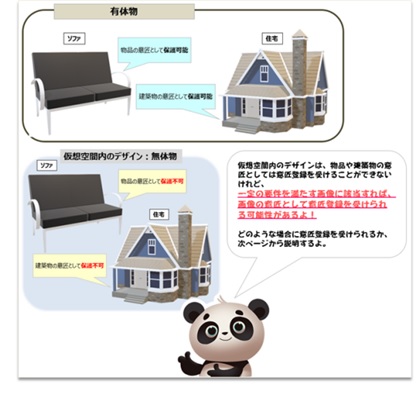
ガイドラインより
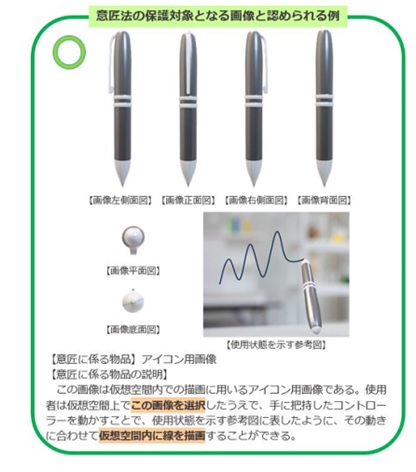
特許庁HPより
Newsletter translated into English

JPO Publishes Guidelines for Designated Goods and Designated Services Related to Virtual Environments and Non-Fungible Tokens (NFTs)
On March 29, 2024, the JPO published guidelines for designated goods and services related to virtual environments and non-fungible tokens (NFTs).
In recent years, applications for trademark registration designating goods and services related to virtual environments have been on the rise against the backdrop of the increasing use of virtual environments in business. To clarify the current handling of matters, the JPO has now prepared guidelines for designating goods and services related to virtual environments and non-fungible tokens (NFTs).
1. Virtual goods
The term “virtual goods” means “digital data for displaying the shape of the goods or the like mainly in virtual environments” (Note 1). Since “virtual goods” is unclear and broad as to what kind of shape of goods, etc. are represented, it is not acceptable alone as an indication of designated goods or services. Also, even if, for example, “virtual clothing” is used, it is unclear and not acceptable alone as an indication of the designated goods or services.
(Note 1) “Virtual environment” refers to “a virtual three-dimensional space built on the Internet where many people can participate and where participants can act freely”.
(1) Indications that are acceptable for designated goods or designated services
From the viewpoint of international harmonization, the following indications are acceptable as indications of designated goods and services.
Class 9: “Downloadable virtual clothing”
Class 9: “Downloadable computer programs for displaying clothing in virtual environments”
Class 9: “Downloadable image files for displaying clothing in virtual environments”
Class 35: “Online retail services for downloadable virtual clothing”
Class 41: “Providing online images for displaying clothing in virtual environments”
Class 42: “Providing computer programs on data networks for displaying clothing in virtual environments”
Also, for all of the above indications the “clothing” part can be replaced by goods listed in the Examination Guidelines for Similar Goods and Services, etc. (i.e., indications that can be adopted as indications of the designated goods by themselves).
(2) Indications that are unacceptable for designated goods or services
Indications in which the “clothing” part of the designated goods or services indicated in (1) above is broad and unclear.
Indications which are similar to but not identical to the designated goods or services indicated in (1) above.
E.g. “downloadable virtual goods“, “downloadable clothing that is virtual“
2. Non-fungible tokens (NFTs)
A “non-fungible token (NFT)” is “digital data that cannot be falsified or tampered with”. It has a function of providing uniqueness to digital data on the blockchain to ensure authenticity, and a function of allowing tracking of transaction histories. The term is also used in the sense of “something valuable that is not a reproduction, such as artwork, and that is embedded with information proving that it is a unique piece data”. Therefore, “non-fungible token (NFT)”, “non-fungible token” and “NFT” are in principle unacceptable as indications of designated goods or services, because their meanings are not identifiable and clear on their own. However, the following indications are acceptable.
Class 9: “Downloadable digital image files authenticated by non-fungible tokens (NFTs)”
Class 9: “Downloadable computer software applications for minting non-fungible tokens (NFTs)”
Class 25: “Clothing authenticated by non-fungible tokens (NFTs)”
Class 35: “Retail services relating to downloadable digital image files authenticated by non-fungible tokens (NFTs)”
Class 35: “Provision of an online marketplace for buyers and sellers of downloadable digital image files authenticated by non-fungible tokens (NFTs)”
Class 35: “Listing of downloadable digital image files authenticated by non-fungible tokens (NFTs) in online marketplaces on behalf of others”
Class 35: “Obtaining authentication by non-fungible tokens (NFTs) for digital image files on behalf of others”
Class 35: “Obtaining authentication by non-fungible tokens (NFTs) for digital image files on behalf of others”
Class 36: “Management of crypto assets authenticated by non-fungible tokens (NFTs)”
Class 42: “Providing online non-downloadable computer software for minting non-fungible tokens (NFTs)”
Also, the terms “non-fungible token (NFT)”, “non-fungible token” and “NFT” are mutually interchangeable.
Reference URLs:
https://www.jpo.go.jp/system/trademark/gaiyo/bunrui/kaso_nft_guideline.html
https://www.jpo.go.jp/system/laws/rule/guideline/trademark/binran/document/index/46_02.pdf
The Cabinet Office’s “Study Group on Intellectual Property in the Age of Age” Presents Draft Outline for Interim Summary.
In response to a subcommittee of the Copyright Subcommittee of the Council for Cultural Affairs compiling its thoughts on AI (Artificial Intelligence) and copyright, the Cabinet Office held an online meeting on March 21 to discuss the current state of generative AI and intellectual property protection, and presented a draft outline for an interim summary.
The study group was established to examine the necessary policies, etc., for dealing with issues concerning the relationship between AI and intellectual property rights, etc., while taking into consideration the arrangements, etc., made by the relevant ministries and agencies. The study group started in October 2023 and this was its 6th session.
The thoughts compiled by the subcommittee of the Copyright Subcommittee of the Council for Cultural Affairs included the presentation of cases in which the use of AI could constitute copyright infringement within the framework of the current Copyright Act. In parallel, the Cabinet Office study group has been discussing the relationship between AI and intellectual property rights in general, including copyrights, design rights, and trademark rights.
“Style” that does not amount to specific expression by the creator was considered not to be subject to protection under the Copyright Act. As for the “voices” of voice actors and others used in the development of AI to generate synthesized voices, it was pointed out that the possibility of being protected by portrait rights “is not high”. On the other hand, as an example of a case that could be subject to regulation under the Unfair Competition Prevention Law, which promotes fair competition among businesses, the illegal acquisition and use of trade secrets and other information during the data learning stage was mentioned.
Based on the draft outline, the study group plans to formulate an interim summary by the end of April, which will be reflected in the government’s IP promotion plan to be released around June.
Reference URLs:
https://www.kantei.go.jp/jp/singi/titeki2/ai_kentoukai/gijisidai/dai6/index.html
https://www.bunka.go.jp/seisaku/bunkashingikai/chosakuken/hoseido/r05_07/pdf/94024201_01.pdf
Guidebook on the Application for Design Registration of Images Used in Virtual Space
With the revision of the Design Law in 2019, the scope of design protection was expanded to include graphic images themselves, which are separated from articles. Since then, virtual environments such as the Metaverse have developed rapidly, and graphic images that can be used in virtual environments also require protection under the Design Law. Many of the images used in virtual environments have properties different from those of conventional graphic images.
In response, a guidebook has been created that outlines the basic concepts of the scope of protection available under the current Design Act and includes illustrative examples of graphic image designs in virtual environments. The guidebook introduces, in the form of case examples, graphic images that are and are not recognized as designs of graphic images subject to protection under the Design Law, and explains how to fill out the application form and list figures.
Key points of the document
– Some graphic images used in virtual space can be protected by design law
– How do you fill out the application form and list figures for a graphic image design application?
– Introduction of graphic images that are and are not recognized as subject to protection under the Design Law, in the form of examples
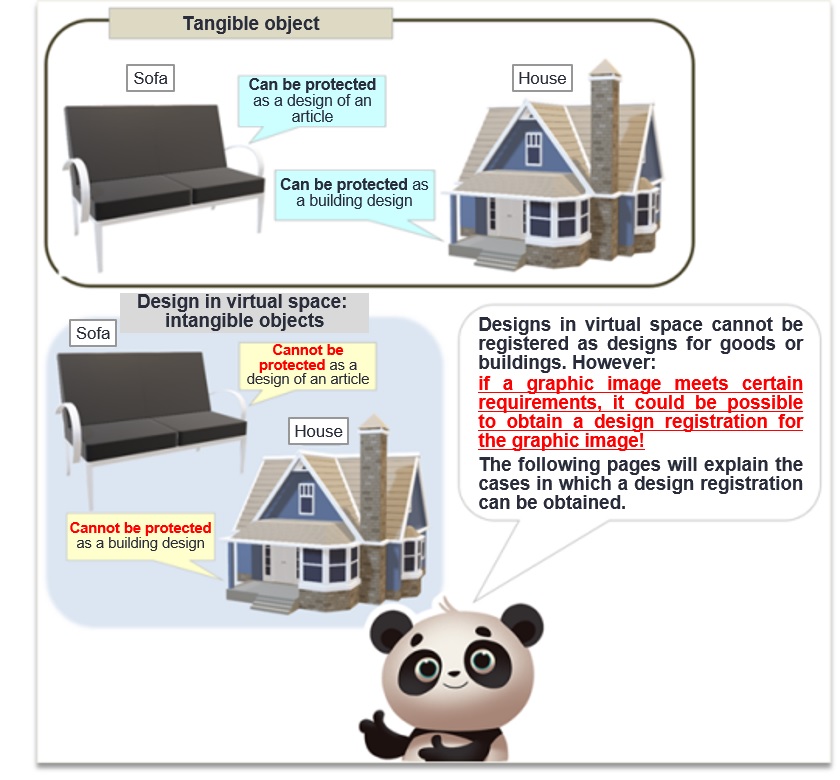
Source: Guidelines
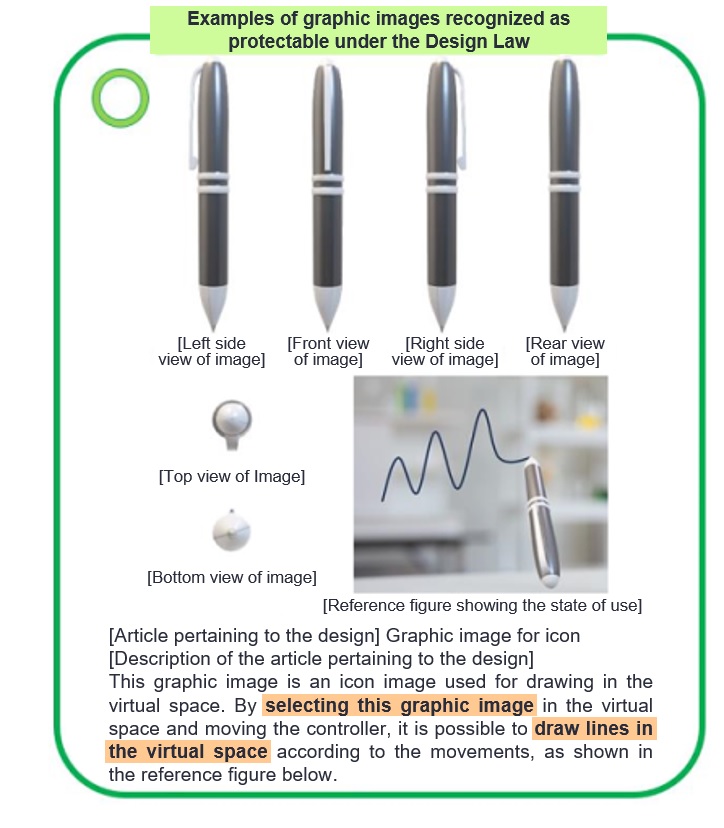
Source: JPO website
